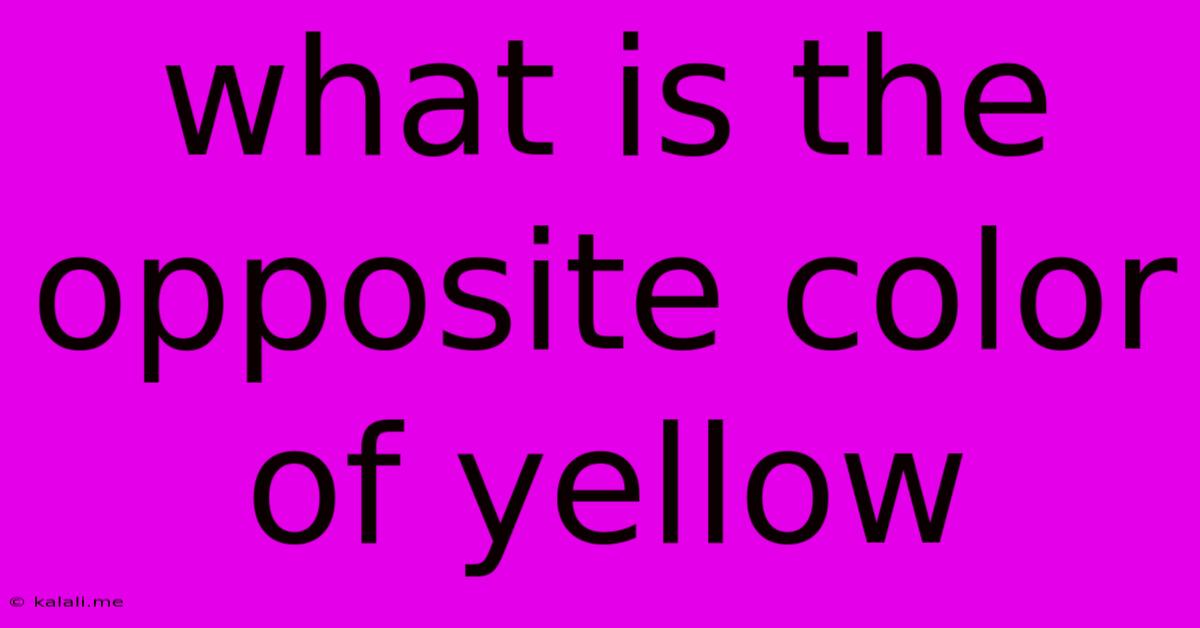What Is The Opposite Color Of Yellow
Kalali
Jun 02, 2025 · 3 min read

Table of Contents
What is the Opposite Color of Yellow? Understanding Complementary Colors
This article explores the fascinating world of color theory and answers the question: what is the opposite color of yellow? We'll delve into the color wheel, explain the concept of complementary colors, and discuss the practical applications of this knowledge in art, design, and even everyday life. Understanding complementary colors can significantly enhance your creative projects and visual appeal.
The simple answer is violet (or purple). However, understanding why violet is the opposite of yellow requires a look at the color wheel.
The Color Wheel and Complementary Colors
The color wheel is a visual representation of colors arranged according to their chromatic relationships. It's a fundamental tool in art and design, helping artists and designers understand color harmony and contrast. The most common type is the RYB (Red, Yellow, Blue) color wheel, although the RGB (Red, Green, Blue) and CMYK (Cyan, Magenta, Yellow, Key/Black) models are also frequently used, depending on the application.
Complementary colors are pairs of colors located directly opposite each other on the color wheel. These colors have the strongest contrast, creating a vibrant and visually striking effect when placed side-by-side. When mixed together, they often produce a muted, neutralized brown or gray.
On a standard color wheel, yellow sits directly opposite violet. This means they are each other's complementary colors. This relationship is based on the way our eyes perceive light and color mixing. Yellow and violet have a strong contrast that makes them visually compelling, capturing attention and creating a sense of energy and vibrancy.
Shades of Violet and its Relationship to Yellow
It's important to note that "violet" encompasses a range of hues, from a deep, rich purple to a lighter, more lavender shade. The precise shade of violet that is considered the "opposite" of yellow can depend slightly on the specific color wheel being used, but the general principle remains the same: they are positioned opposite each other on the spectrum.
The intensity of the yellow also matters. A bright, sunshine yellow will contrast best with a vibrant violet. A more muted, pastel yellow will find its complement in a similarly softer violet shade.
Practical Applications of Complementary Colors
Understanding complementary colors, like yellow and violet, has numerous applications:
- Art and Design: Artists use complementary colors to create striking contrasts in paintings, sculptures, and other artwork. This can add depth, dynamism, and visual interest to the piece.
- Fashion and Interior Design: Complementary colors can be used to create visually appealing clothing combinations or to enhance the aesthetics of a room. A yellow accent wall with violet furniture, for instance, can create a sophisticated and stylish look.
- Branding and Marketing: Businesses often utilize complementary colors in their logos and branding materials to create a memorable and impactful visual identity.
- Graphic Design: Complementary color schemes are frequently used in website design, brochures, and other marketing materials to enhance readability and visual appeal.
In conclusion, while the exact shade might vary slightly depending on the color model, the opposite color of yellow is indeed violet. Understanding this fundamental concept of complementary colors opens up a world of creative possibilities in various fields. So next time you are working on a creative project, remember the power of these contrasting colors!
Latest Posts
Latest Posts
-
Adding A Second Ac Unit To House Cost
Jun 04, 2025
-
Davinci Resolve Toggle Node On Off
Jun 04, 2025
-
Denver To Salt Lake City Driving
Jun 04, 2025
-
Can You Use Coconut Oil To Fry
Jun 04, 2025
-
2014 Ford Fusion Radio Wiring Diagram
Jun 04, 2025
Related Post
Thank you for visiting our website which covers about What Is The Opposite Color Of Yellow . We hope the information provided has been useful to you. Feel free to contact us if you have any questions or need further assistance. See you next time and don't miss to bookmark.